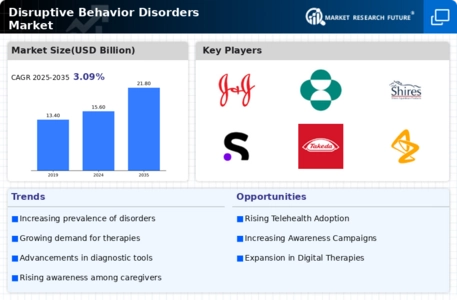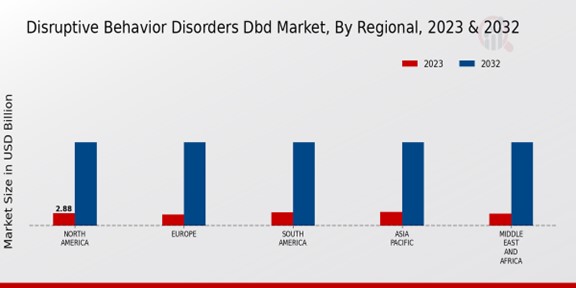Policy and Regulatory Support
Supportive policies and regulations from governments worldwide are playing a pivotal role in shaping the Global Disruptive Behavior Disorders Market Industry. Legislative measures aimed at improving mental health services and funding for research into disruptive behavior disorders are becoming more prevalent. For instance, various countries are implementing mental health parity laws that ensure equal coverage for mental health treatment. Such policies not only enhance access to care but also encourage the development of new therapeutic options. This regulatory environment is expected to contribute to a steady market growth rate, with a projected CAGR of 3.09% from 2025 to 2035.
Advancements in Treatment Modalities
Innovations in treatment modalities for disruptive behavior disorders are significantly influencing the Global Disruptive Behavior Disorders Market Industry. The development of evidence-based therapies, including cognitive-behavioral therapy and parent management training, appears to enhance treatment efficacy. Furthermore, the integration of technology in therapeutic practices, such as teletherapy and mobile applications, is likely to improve accessibility for patients. These advancements not only foster better patient outcomes but also attract investments from healthcare providers. As a result, the market is projected to reach a value of 21.8 USD Billion by 2035, reflecting the growing demand for effective treatment solutions.
Rising Awareness and Education Initiatives
The Global Disruptive Behavior Disorders Market Industry is bolstered by increasing awareness and educational initiatives aimed at parents, educators, and healthcare professionals. Campaigns designed to inform stakeholders about the signs and symptoms of disruptive behavior disorders are crucial in promoting early diagnosis and intervention. Organizations and governments are investing in training programs that equip professionals with the necessary skills to identify and manage these disorders effectively. This heightened awareness is likely to lead to an increase in diagnosed cases, thereby driving market growth. As the industry evolves, it is essential to sustain these educational efforts to ensure comprehensive care.
Integration of Mental Health Services in Schools
The integration of mental health services within educational institutions is emerging as a key driver for the Global Disruptive Behavior Disorders Market Industry. Schools are increasingly recognizing the importance of addressing mental health issues among students, leading to the implementation of on-site counseling and behavioral intervention programs. This proactive approach aims to identify and support students exhibiting disruptive behaviors early on, thereby reducing the long-term impact of these disorders. As educational systems adapt to include mental health resources, the demand for specialized services is likely to rise, further propelling market growth.
Increasing Prevalence of Disruptive Behavior Disorders
The Global Disruptive Behavior Disorders Market Industry is experiencing growth due to the rising prevalence of disorders such as Oppositional Defiant Disorder and Conduct Disorder among children and adolescents. Recent statistics indicate that approximately 3.5% of children globally are diagnosed with these disorders, which translates to millions of affected individuals. This increasing prevalence necessitates enhanced treatment options and interventions, thereby driving market expansion. As awareness grows, healthcare systems are compelled to allocate more resources towards addressing these disorders, contributing to the projected market value of 15.6 USD Billion in 2024.























Leave a Comment